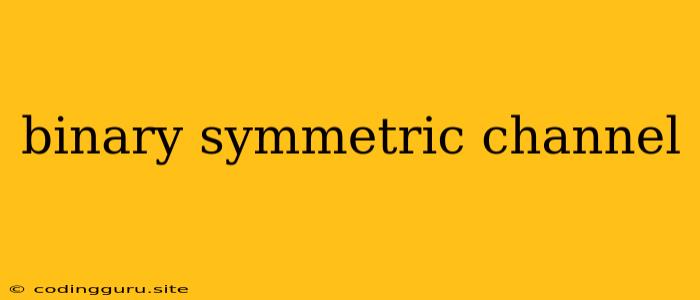What is a Binary Symmetric Channel (BSC)?
The Binary Symmetric Channel (BSC) is a fundamental concept in communication theory and information theory. It's a simple yet powerful model used to represent a noisy communication channel where bits (0s and 1s) are transmitted and received. The key characteristic of a BSC is that it introduces errors with a specific probability, independently for each bit.
How Does it Work?
Imagine you want to send a message across a noisy channel, like a radio transmission or a network connection. You encode your message into bits, and each bit is transmitted individually. During transmission, the bit might get corrupted due to noise or interference.
The BSC model assumes that each bit has a fixed probability of being flipped during transmission. This probability is known as the channel error probability and is usually denoted by 'p'.
For example:
- If the channel error probability 'p' is 0.1, it means there is a 10% chance that any given bit will be flipped during transmission.
- If a '0' is transmitted, there's a 10% chance it will be received as a '1' and a 90% chance it will be received correctly as a '0'.
- Similarly, if a '1' is transmitted, there's a 10% chance it will be received as a '0' and a 90% chance it will be received correctly as a '1'.
Key Characteristics of a BSC
- Symmetry: The probability of flipping a '0' to a '1' is the same as the probability of flipping a '1' to a '0'.
- Memoryless: Each bit transmission is independent of the previous ones. The channel doesn't "remember" past errors.
- Binary: The channel operates on binary symbols (0s and 1s).
Why is the BSC Important?
The BSC model is crucial for understanding various communication systems and information theory concepts:
- Error Detection and Correction: The BSC helps develop algorithms and techniques for detecting and correcting errors introduced during transmission. Codes like Hamming codes and parity codes are designed to overcome errors introduced by the BSC.
- Capacity Calculation: The channel capacity, which represents the maximum rate at which information can be transmitted reliably through a channel, can be calculated for the BSC. This gives us a theoretical limit on how much data we can send without errors.
- Performance Evaluation: The BSC provides a simple framework for evaluating the performance of different communication systems. By simulating data transmission through the BSC, we can assess the error rate, reliability, and efficiency of a system.
Real-World Examples of BSC
While the BSC is an idealized model, it provides a good approximation for many real-world scenarios:
- Wireless Communication: Radio waves can be affected by atmospheric noise, interference from other devices, and fading, resulting in bit errors.
- Storage Media: Magnetic hard drives and flash memory can experience bit errors due to physical defects or wear and tear.
- Optical Fiber Communication: Fiber optic cables can be affected by noise and interference, leading to signal degradation and bit errors.
Conclusion
The Binary Symmetric Channel (BSC) is a fundamental building block in communication and information theory. Its simplicity and clear mathematical formulation make it valuable for understanding noise effects, designing error correction codes, and evaluating the performance of communication systems. While it's an idealized model, it provides a useful framework for understanding the challenges of reliable communication in the presence of noise.
